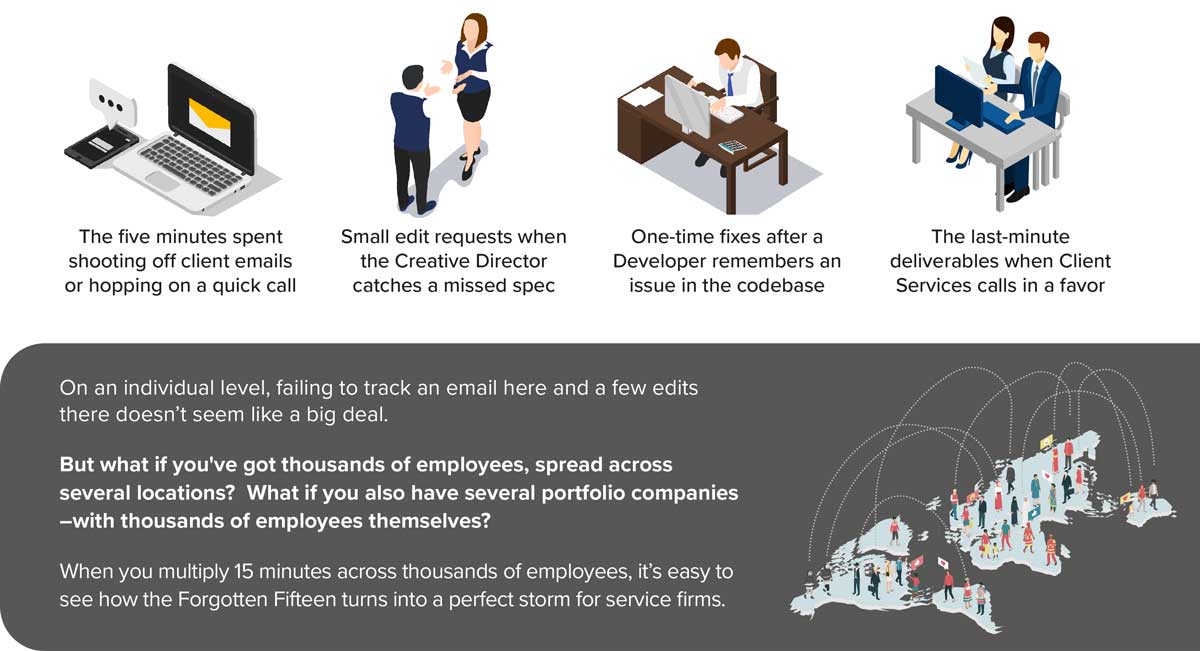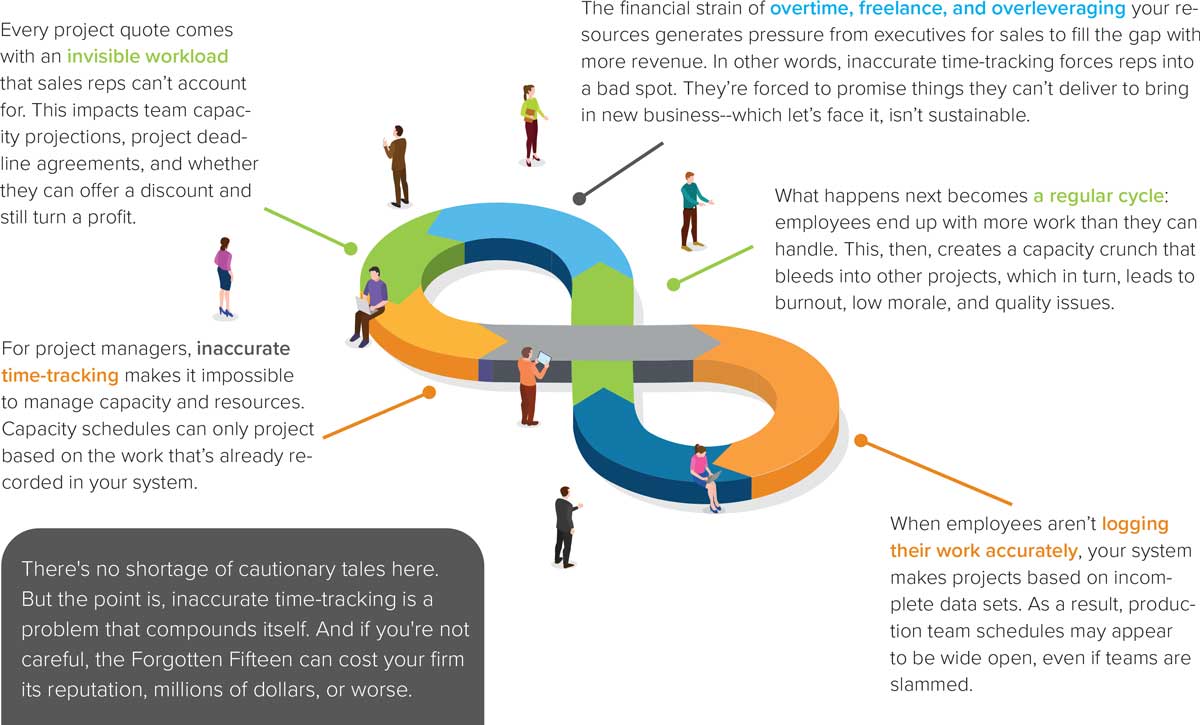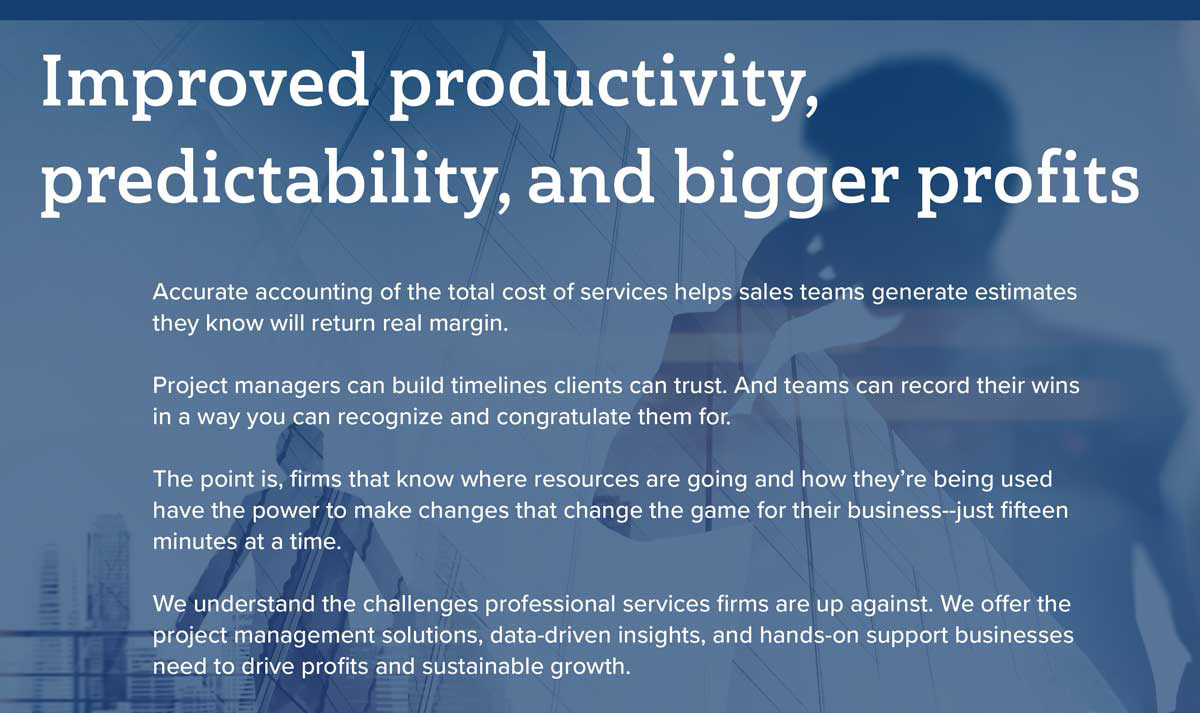The Forgotten Fifteen: How Inaccurate Time Tracking Can Compromise Project Margins
Creative, financial and technical services organizations are unique in that they deal in knowledge. Employee insight and expertise is the product.
Time logged translates to money in the bank, but only when a project comes in under budget. At the enterprise level, operations span hundreds to thousands of billable resources across a wide range of verticals, service lines, and customer segments. Projects can last for months, years at a time. And success is determined by a combination of profit, resource utilization, process alignment, and most importantly--client experience. The truth is, no matter how good the work or how happy your customers are, without accurate time- tracking, everything falls apart.
Read on and we’ll explain why and what you can do to get ahead of this problem. ❱ ❱ ❱
Enter the "Forgotten Fifteen"...
The "Forgotten Fifteen" is a term we use to describe the small day-to-day tasks that never make it onto a client invoice or even a Gantt chart. We're talking about:

Why Track the Forgotten Fifteen?
Tracking the Forgotten Fifteen isn’t about spying on your teams to make sure they’re “busy.” It’s about gathering data you can use to increase profit margins. Time- tracking enables firms to boost profits by maximizing efficiency and boosting productivity.
|
|
Why Accuracy Matters
When knowledge is the product, knowing how much you’re selling is the first step toward regaining control over the bottom line. When time and labor aren’t recorded, every estimate is based on bad data, and those miscalculations ripple through the entire business. As an example, consider the project lifecycle:

3 Fundamentals For Tracking The Forgotten Fifteen Across Your Organization
In order to track the Forgotten Fifteen, a few key things must be in place. You’ll need a unified data system that spans all areas of your business--including any portfolio businesses. You’ll also need the right tools, along with the policies and workflows that ensure everyone does their part.
Here’s a basic overview of what that entails:
- Centralize your data
Professional services firms need accurate data, real-time insights and complete visibility into what's going on with every project, client, and team. With granular insight into what's impacting your profit margins right now, you can spot at-risk projects and take action before it wreaks havoc on the bottom line. For that, you'll need to make sure that all systems, locations, business functions align around a single source of truth. - Assemble your time-tracking tech stack
Teams have all kinds of reasons for not tracking their time. One common complaint is many time-tracking solutions are more trouble than they’re worth. Employees are required to log hours in an Excel sheet or an app that’s completely dis- connected from the tools they use on the job. What ends up happening is, employees end up writing off billable hours to fast-track client work. Instead, make sure your time and expense entry systems integrate with the tools your team uses each day.
Beyond time-tracking itself, you'll also need an integrated project management and accounting tool like Advanced Projects for Microsoft Dynamics 365 Business Central. Advanced projects offers time tracking integrations for Outlook, Azure DevOps, and JIRA, alongside end-to- end cloud-based project management- -covering everything from time-entry and approvals to capacity planning, budgeting, and project-specific analytics and insights. - Rethink your workflows & processes
While good data and the right tools are essential for accu-
rate time-tracking, they can’t work their magic if your strategy
is no good. Before you make any big decisions, you’ll want to review your existing time-tracking, project manage- ment, and reporting methods. Ask yourself the following questions:- How are you currently logging billable hours?
- Are teams following company billing guidelines?
- Do you even have clearly-defined billing guidelines – and are they consistent across departments/locations?
- What needs to happen to improve accuracy and compliance?
- How do you allocate resources
- How do you typically assign projects to employees?
- How is work distributed – are some employees overworked, while others struggle to fill their days?

Kate Hermansen, MBA | Director of Business Consulting
Since 2021, Kate has led an experienced team of consultants as the Director of Business Consulting. In this role, she empowers organizations to envision new possibilities, achieve goals faster, and operate with greater efficiency.
Contact us today to learn more.




